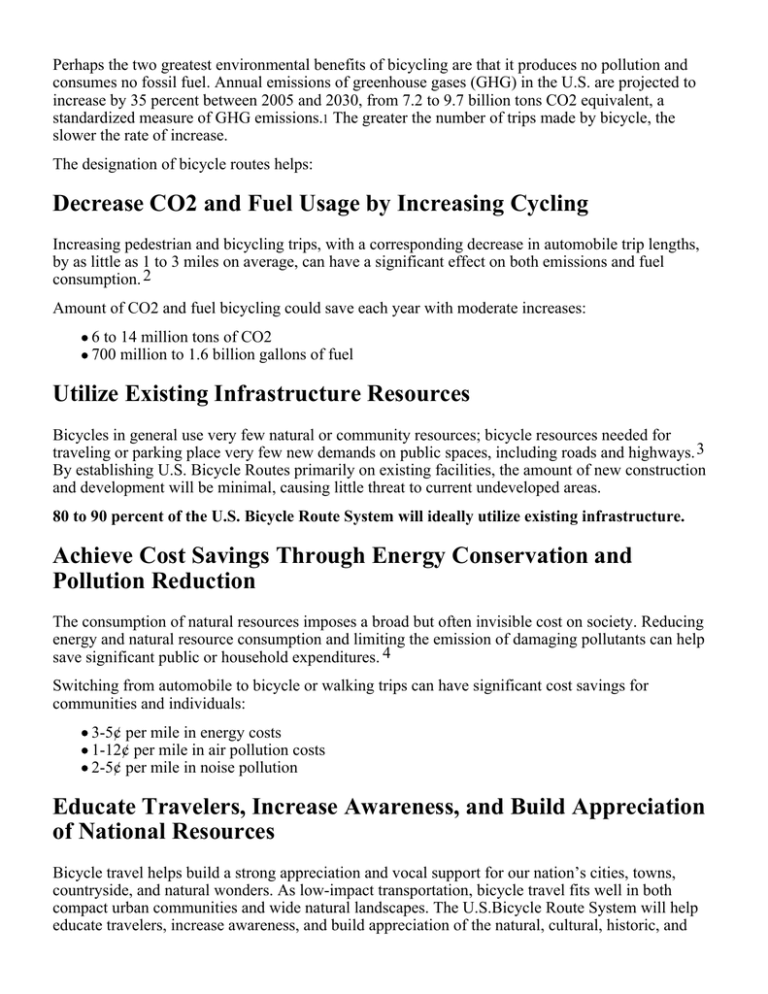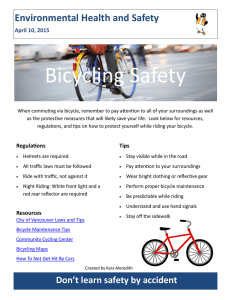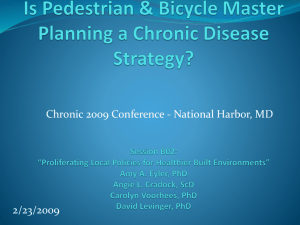Decrease CO2 and Fuel Usage by Increasing Cycling Utilize
advertisement

Perhaps the two greatest environmental benefits of bicycling are that it produces no pollution and consumes no fossil fuel. Annual emissions of greenhouse gases (GHG) in the U.S. are projected to increase by 35 percent between 2005 and 2030, from 7.2 to 9.7 billion tons CO2 equivalent, a standardized measure of GHG emissions.1 The greater the number of trips made by bicycle, the slower the rate of increase. The designation of bicycle routes helps: Decrease CO2 and Fuel Usage by Increasing Cycling Increasing pedestrian and bicycling trips, with a corresponding decrease in automobile trip lengths, by as little as 1 to 3 miles on average, can have a significant effect on both emissions and fuel consumption. 2 Amount of CO2 and fuel bicycling could save each year with moderate increases: 6 to 14 million tons of CO2 700 million to 1.6 billion gallons of fuel Utilize Existing Infrastructure Resources Bicycles in general use very few natural or community resources; bicycle resources needed for traveling or parking place very few new demands on public spaces, including roads and highways. 3 By establishing U.S. Bicycle Routes primarily on existing facilities, the amount of new construction and development will be minimal, causing little threat to current undeveloped areas. 80 to 90 percent of the U.S. Bicycle Route System will ideally utilize existing infrastructure. Achieve Cost Savings Through Energy Conservation and Pollution Reduction The consumption of natural resources imposes a broad but often invisible cost on society. Reducing energy and natural resource consumption and limiting the emission of damaging pollutants can help save significant public or household expenditures. 4 Switching from automobile to bicycle or walking trips can have significant cost savings for communities and individuals: 3-5¢ per mile in energy costs 1-12¢ per mile in air pollution costs 2-5¢ per mile in noise pollution Educate Travelers, Increase Awareness, and Build Appreciation of National Resources Bicycle travel helps build a strong appreciation and vocal support for our nation’s cities, towns, countryside, and natural wonders. As low-impact transportation, bicycle travel fits well in both compact urban communities and wide natural landscapes. The U.S.Bicycle Route System will help educate travelers, increase awareness, and build appreciation of the natural, cultural, historic, and environmental resources of our nation. environmental resources of our nation. Related Research European Cycle Route Network EuroVelo: Challenges and Opportunities for Sustainable Tourism is a 2009 study by the European Parliament which concluded that cycle tourism has a major role to play in a more sustainable future for domestic and international tourism across Europe. Low Carbon Travel Fact Sheet: Reducing the Climate Change Impact of Road Transport (PDF) is a comprehensive information sheet produced by the UK's Sustrans, the organization behind the development of the National Cycle Network. 1) Jon Creyts, Anton Derkach, Scott Nyquist, Ken Ostroski, Jack Stephenson. Reducing U.S. Greenhouse Gas Emissions: How Much at What Cost? (McKinsey &Company, U.S. Greenhouse Gas Abatement Mapping Initiative Executive Report, December 2007); 2) Thomas Gotschi, Ph.D. and Kevin Mills, J.D. Active Transportation for America. The Case for Federal Investment in Bicycling and Walking. (Rails-to-Trails Conservancy, 2008); 3) US DOT, FHWA. Case Study No. 15 The Environmental Benefits Of Bicycling And Walking. Publication No. FHWA-PD-93-015. Retrieved from http://atfiles.org/files/pdf/BikePedBen.pdf; 4) Litman, Todd. Quantifying the Benefits of Nonmotorized Transportation For Achieving Mobility Management Objectives. (Victoria Transport Policy Institute, September 2009). Retrieved from http://www.vtpi.org/nmt-tdm.pdf.






